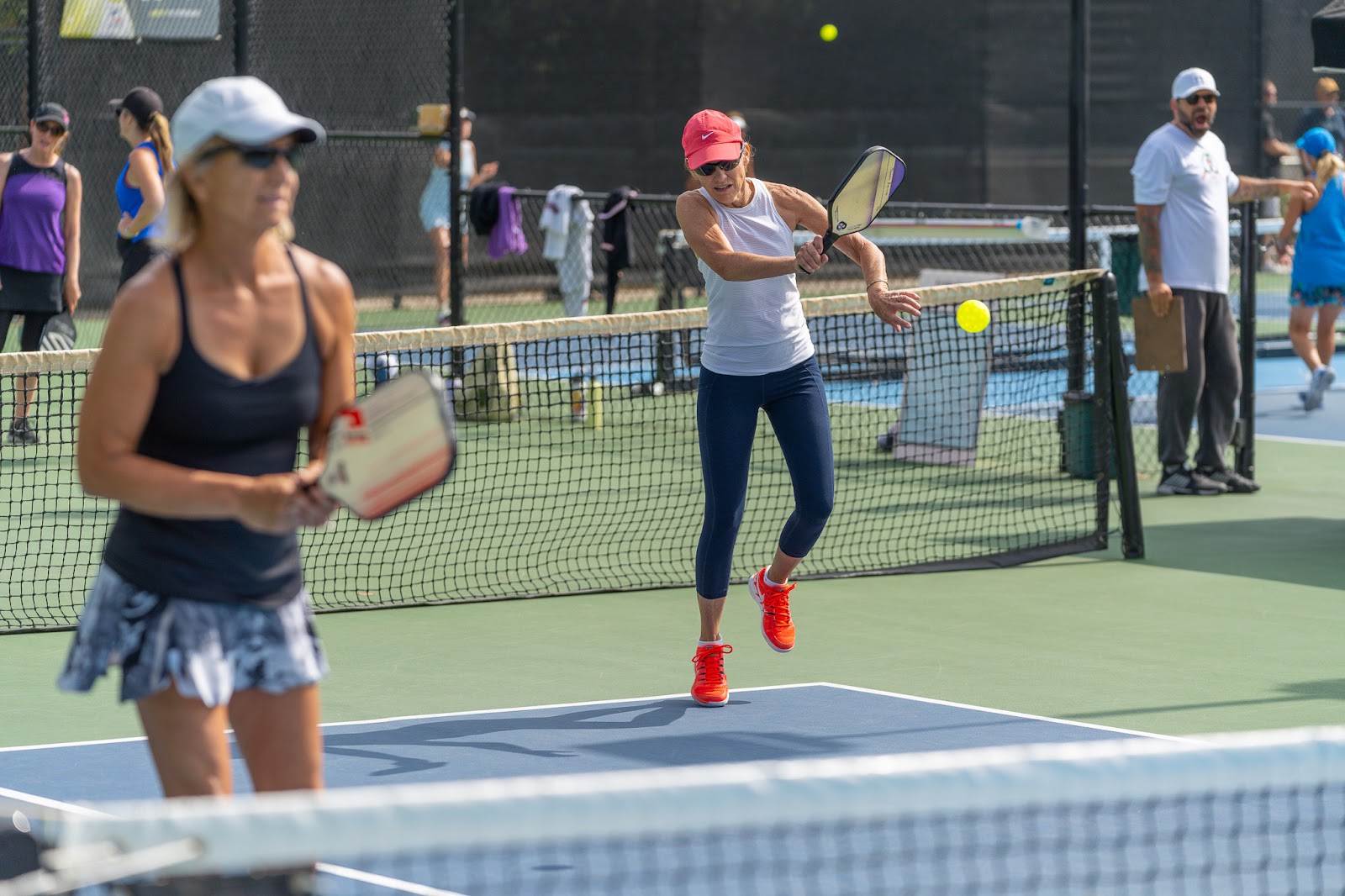Fitness vs court shoes (and what is the difference?)
It is important to have the right gear for your workout whether you are a “weekend warrior” or a dedicated daily athlete. Improper fit of a product can make you uncomfortable, hinder your movements, and distract you from your training.
Clothing, shoes, hats, sunglasses, water bottles, and sports drinks are critical accessories to consider that can impact your performance.
At Paseo Club, we have been coaching and mentoring athletes of all ages for over 19 years, and we know how important it is to be at the top of your game.
In this article, we will tell you everything you need to know about fitness shoes versus court shoes. We will review how these shoes differ, how they are designed, why you need different types of shoes depending on the activity, and what to look for when shoe shopping.
Fitness Shoes
What is a fitness shoe?
A fitness shoe is also called a cross-trainer or trainer.
They have been developed to be a multi-purpose shoe that can be used for a variety of sports and exercises.
Training shoes provide cushioning as well as varying levels of stability devised to protect the feet and ankles.
When to wear fitness shoes
Fitness shoes are shoes that get used for a range of exercises including:
- Light running
- Walking
- Weight lifting
- Jump roping
- Zumba
- HIIT (high-intensity interval training).
What are the characteristics of a fitness shoe?
Fitness shoes are not shoes for a specific sport. They are designed to be the “jack-of-all-trades” of shoes. Typical characteristics of a fitness shoe are:
- Even footbed/minimal heel drop
- Good shock absorption capacity
- Durable design
- Moderate cushioning
- Flexible midsole
- Stable base
- Light-weight breathable materials
- Seam-free construction
Why are fitness shoes designed with this type of construction?
Many athletic shoes are designed for one specific purpose; the shoe reflects the needs of that sport. Basketball shoes are tall for ankle support. Running shoes are extra-cushioned to protect your joints from constant impact.
But fitness shoes are unique in that they have been constructed for multiple uses with an eye toward diversity. They should be comfortable, stable, and supportive.
Fitness shoes also need to be flexible to be used for many kinds of movement — pivoting, jumping, and squatting.
 What should consumers look for in a fitness shoe?
What should consumers look for in a fitness shoe?
It is recommended you try on many brands of shoes when you are shoe shopping.
Sometimes store employees can analyze your feet and assess you for pronation or supination. Then they can make recommendations for shoes based on that information.
Always prioritize comfort when selecting any shoe. The length of the shoe should be correct for your foot and your toes must be able to spread out adequately in the toe box.
Ensure the shoe has flexibility, modest to zero heel height, and good ventilation. The shoe needs to have some cushion but not be overly bulky or thick. Fitness shoes tend to be more minimalist in their design.
Examples of good fitness shoes are Reebok Nano or Nike Metcon.
Court Shoes
What is a court shoe?
A court shoe is a shoe designed specifically for use on tennis or pickleball courts.
What activities can court shoes be used for?
Though court shoes are used primarily for tennis, they can be worn for other sports as well.
- Squash
- Racquetball
- Pickleball
- Badminton
- Volleyball
- Basketball
- Streetball
What are the characteristics of a court shoe?
Court shoes are designed specifically for the needs of tennis and pickleball players.
These shoes are made to give you the support, cushioning, and traction you need on a court.
- Stable bottom prevents players from rolling an ankle while moving quickly from side to side
- Uppers made from leather or vinyl for durability
- Ample cushion and shock absorption for playing on a hard surface
- White rubber soles won't leave skid marks on the court surface
- Patterned soles for traction
Why are court shoes designed with this type of construction?
We all know that tennis requires not just a lot of running around, but moving backward, lunging, sidestepping, and even sliding.
Tennis and pickleball players also do a lot of lateral movement. With that in mind, shoe manufacturers designed tennis shoes with high durability, offering a more resilient outsole, and more supportive upper using leather or vinyl.
Court shoes are also constructed to provide you with exactly the type of support and cushioning that you need for playing multiple games every week. This support helps to insulate and protect your joints from the impact of the sport.
The sole of the shoe varies depending on the court surface. Herringbone is the most common and is appropriate for hard surfaces, but grass courts can be slippery, so a dimpled or nubbed sole is a better fit.
What should consumers look for in a court shoe? (3 types)
There are three different styles of court shoes based on the type of court.
Because there are so many court shoes to choose from, your decision should not be just about the different colors and fancy designs on the exterior but what the intended purpose is for the shoe.
Hard court shoes
Hard courts are courts constructed of asphalt with layers of color coating.
The job of these court shoes is to give you traction. They are made to be durable because hard courts can be very taxing on your shoes.
The midsole provides cushioning because playing on asphalt courts can be tougher on joints — the starting and stopping are more jarring.
The soles are white or light-colored, never black.
 Clay court/Har-Tru shoes
Clay court/Har-Tru shoes
Clay courts are just that — a court made from clay.
Clay court/har-tru shoes have lined or herringbone patterns across the sole to help grip in to the clay without retaining it. This is done to prevent your shoe from becoming too slippery which will make you slide around and even fall.
Clay court shoes are designed with more lateral support in the upper because so much more sliding does occur.
The upper is tighter and is made from solid material (as opposed to a mesh-type fabric) because it helps prevent the clay from getting inside the shoe.
Grass court shoes
Grass court shoes are specialized shoes.
The bottom of the shoes has little nubs or rubbery cleats to help grip into the very slippery grass surface.
These shoes are only for use on grass courts. They cannot be used on hard courts or clay courts.
Examples of good court shoes are Asics Gel Resolution 8 and Nike Court React Vapor NXT.
Are there hybrid shoes for both fitness and court games?
Unfortunately, no.
You need to have a pair of shoes for the court and a separate pair for fitness because you need shoes that match the requirements of your activity.
Each pair of shoes are designed distinctly based on the different specific movements of that sport.
The only exception is, if you only play tennis or pickleball occasionally, and tend to focus on fitness and weights, then a pair of cross-training shoes might do.
And one more thing, don’t go on long or frequent runs in your trainers or tennis shoes. You will need a third pair of shoes just for running.
Learning about your fitness options
In this article, we compared fitness shoes versus court shoes.
Hopefully, you now have a good understanding of their unique designs and why you need a pair of each type of shoe if you play tennis or pickleball and attend fitness classes.
At Paseo Club in the Santa Clarita Valley, we have both tennis and pickleball courts that are open year-round as well as junior programs, tournaments, and other special events.
There are also over 60 fitness classes available each week. Members can choose from cycle, yoga, cardio strength, Pilates, water aerobics, and more.
If you aren’t a member but would like to be one, join now and come be a part of our healthy, social community.
Jen Azevedo is a tennis professional, pickleball professional, personal trainer, group exercise instructor, and the general manager of the Paseo Club. She loves the community at the Paseo Club and that it is also a safe and fun place for her daughter. Jen’s favorite activities are joining her tribe for trail races or her partners for tennis matches. Occasionally Jen slows down to relax with a book — she reads over 100 a year!
Topics:

